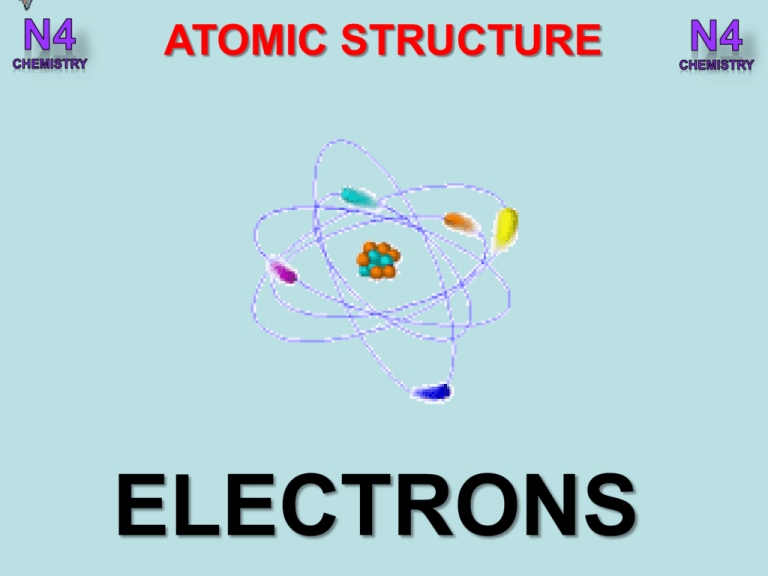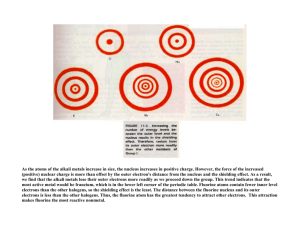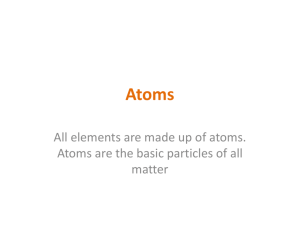Alkali metals Halogens Noble gases
advertisement

ATOMIC STRUCTURE ELECTRONS ATOMIC STRUCTURE ELECTRONS After completing this topic you should be able to : • State electrons in an atom are arranged in energy levels. • State the elements of the Periodic Table are arranged in terms of their atomic number and chemical properties. • State those elements with the same number of outer electrons have similar chemical properties. • Locate the following families of elements in the Periodic Table: Alkali metals Halogens Noble gases ELECTRONS ENERGY LEVELS The electrons in an atom orbit around the nucleus. This means electrons posses energy. In 1913, Niels Bohr worked out that electrons only orbit the nucleus at certain distances called ENERGY LEVELS. Niels Bohr (1885 – 1962) 3rd 2nd 1st nucleus + The first energy level can hold 2 electrons. The second energy level can hold 8 electrons. The third energy level can hold 8 electrons. Increasing energy Electrons fill up the lowest energy levels first. ELECTRON ARRANGEMENT How the electrons fill up the energy levels in an atom is called the ELECTRON ARRANGEMENT. 14 Si 2, 8, 4 14+ 2, 8, 4 The electron arrangements of atoms can be found in the Chemistry Data Booklet. Complete the Electron Arrangements of Selected Elements sheet by writing the electron arrangements of the atoms. CHEMICAL PROPERTIES When atoms react and join they use their outer electrons on their atoms. These electrons are the first particles the atoms meet when they approach each other to join. The outer electrons on an atom are responsible for the CHEMICAL PROPERTIES. GROUP I – ALKALI METALS The metals in group I are called the ALKALI METALS. Complete the Alkali Metals strip by writing the electron arrangements of the atoms. Your teacher will demonstrate the properties of lithium, sodium and potassium. CHEMICAL PROPERTIES When atoms react and join they use their outer electrons on their atoms These electrons are the first particles the atom meet when they approach each other to join. The outer electrons on an atom are responsible for the CHEMICAL PROPERTIES. Li All the alkali metals have 1 electron in the outer energy level of their atoms. Li, Na and K are stored in oil to protect them from moisture and oxygen in the air. Na Li, Na and K are soft and cut easily. The freshly cut surfaces rapidly tarnish. Li, Na and K react vigorously with water and produce an alkaline solution. K Going down group I the reactivity of the metals increase. All group I – alkali metal atoms have 1 electron in their outer energy level. GROUP VII – THE HALOGENS Complete the HALOGENS strip by writing the electron arrangements of the atoms. The non-metals in group VII are called the HALOGENS. F Cl Fluorine is a pale yellow gas. Chlorine is a pale green gas. GROUP VII – THE HALOGENS Br I At Bromine is a brown liquid. Iodine is a dark purple solid. The halogens are all very reactive. Their reactivity decreases going down the group. Astatine is man-made element which is radioactive. All group VII – halogen atoms have 7 electrons in their outer energy level. GROUP 0 – THE NOBLE GASES Complete the NOBLE GASES strip by writing the electron arrangements of the atoms. The non-metals in group 0 are called the NOBLE GASES. He Ne Helium is used for filling balloons. Neon is used in advertising lights. Ar Kr Xe Argon is used in lasers. Krypton is used in special light bulbs. Xenon is used in the bulbs in camera flashguns and stroboscopes. Apart from helium, all group 0 - noble gas atoms have 8 electrons in their outer energy level. The helium atom only contains 2 electrons. The chemical properties of an atom depend on the number of electrons in the outer energy level. All the atoms in the same group have the same number of electrons in the outer energy level of their atoms which gives them similar chemical properties. Complete the labelling and colouring of the periodic table and stick this in your notes.





